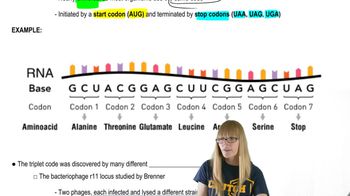Here are the essential concepts you must grasp in order to answer the question correctly.
Anticodon and Codon Pairing
Anticodons are sequences of three nucleotides in tRNA that pair with complementary codons in mRNA during translation. Each codon in mRNA corresponds to a specific amino acid, and the pairing is crucial for accurate protein synthesis. Understanding how anticodons match with codons is essential for interpreting genetic information.
Recommended video:
Translation:Wobble Hypothesis
Wobble Hypothesis
The wobble hypothesis explains how the third base of a codon can be less specific in pairing with the corresponding anticodon. This flexibility allows a single tRNA to recognize multiple codons that code for the same amino acid, enhancing the efficiency of protein synthesis. This concept is vital for understanding the redundancy in the genetic code.
Recommended video:
Translation:Wobble Hypothesis
Genetic Code Redundancy
The genetic code is described as redundant because multiple codons can encode the same amino acid. This redundancy is a result of the 64 possible codons (combinations of three nucleotides) coding for only 20 amino acids. Recognizing this redundancy is important for predicting how different codons can pair with anticodons, especially when considering wobble pairing.
Recommended video:
 Verified step by step guidance
Verified step by step guidance Verified video answer for a similar problem:
Verified video answer for a similar problem:

